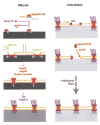Nuclear pore complexes: guardians of the nuclear genome - PubMed (original) (raw)
Review
Nuclear pore complexes: guardians of the nuclear genome
M Capelson et al. Cold Spring Harb Symp Quant Biol. 2010.
Abstract
Eukaryotic cell function depends on the physical separation of nucleoplasmic and cytoplasmic components by the nuclear envelope (NE). Molecular communication between the two compartments involves active, signal-mediated trafficking, a function that is exclusively performed by nuclear pore complexes (NPCs). The individual NPC components and the mechanisms that are involved in nuclear trafficking are well documented and have become textbook knowledge. However, in addition to their roles as nuclear gatekeepers, NPC components-nucleoporins-have been shown to have critical roles in chromatin organization and gene regulation. These findings have sparked new enthusiasm to study the roles of this multiprotein complex in nuclear organization and explore novel functions that in some cases appear to go beyond a role in transport. Here, we discuss our present view of NPC biogenesis, which is tightly linked to proper cell cycle progression and cell differentiation. In addition, we summarize new data suggesting that NPCs represent dynamic hubs for the integration of gene regulation and nuclear transport processes.
Figures
Figure 1. Composition of the NPC
Schematic of the yeast (left) and mammalian (right) NPCs. The framed boxes represent individual Nups or subcomplexes. The transmembrane Nups are depicted in orange, the soluble scaffold components in red, the central core Nups in grey, the components of the cytoplasmic filaments in purple and the members of the nuclear basket in blue. Note that the relative position of the components is not meant to represent the structure of the NPC beyond this general organization.
Figure 2. Model for mammalian NPC assembly mechanisms in mitosis and interphase
The sequences of events leading to post-mitotic (left) or interphase (right) NPC assembly are represented from top to bottom. The chromatin is depicted in grey, the intensity of the color reflecting its compaction state.
Figure 3. A schematic representation of three alternative hypotheses for the functional roles of the genome-NPC contacts
As demonstrated in yeast, the NE-embedded NPCs may bind active genes at opposing ends, forming gene loops, to establish assembled transcription and processing domains that are “remembered” through cell divisions. Alternatively, and as may be more prevalent in metazoa, the NE-associated NPCs may interact with boundary or non-transcribing genomic regions to similarly set up gene expression domains or general nuclear chromatin organization. An intriguing possibility would be the use of such contacts for “remembering” a particular chromatin organization in differentiating or differentiated cells, the latter of which do not turn over their NPCs and remain stable over long periods of time. Finally, NE-independent NPC components may bind active genes in the nucleoplasm for the similar purposes of setting up local transcription and processing organization, which may involve gene looping or even gene contacts between distant loci.
Similar articles
- Functional interactions between nucleoporins and chromatin.
Liang Y, Hetzer MW. Liang Y, et al. Curr Opin Cell Biol. 2011 Feb;23(1):65-70. doi: 10.1016/j.ceb.2010.09.008. Epub 2010 Oct 26. Curr Opin Cell Biol. 2011. PMID: 21030234 Free PMC article. Review. - Nuclear envelope insertion of spindle pole bodies and nuclear pore complexes.
Jaspersen SL, Ghosh S. Jaspersen SL, et al. Nucleus. 2012 May-Jun;3(3):226-36. doi: 10.4161/nucl.20148. Epub 2012 May 1. Nucleus. 2012. PMID: 22572959 Free PMC article. Review. - Ubiquitylation of the nuclear pore complex controls nuclear migration during mitosis in S. cerevisiae.
Hayakawa A, Babour A, Sengmanivong L, Dargemont C. Hayakawa A, et al. J Cell Biol. 2012 Jan 9;196(1):19-27. doi: 10.1083/jcb.201108124. Epub 2012 Jan 2. J Cell Biol. 2012. PMID: 22213798 Free PMC article. - The Nuclear Pore Complex in Cell Type-Specific Chromatin Structure and Gene Regulation.
Sun J, Shi Y, Yildirim E. Sun J, et al. Trends Genet. 2019 Aug;35(8):579-588. doi: 10.1016/j.tig.2019.05.006. Epub 2019 Jun 15. Trends Genet. 2019. PMID: 31213386 Review. - Nuclear pore biogenesis into an intact nuclear envelope.
Doucet CM, Hetzer MW. Doucet CM, et al. Chromosoma. 2010 Oct;119(5):469-77. doi: 10.1007/s00412-010-0289-2. Epub 2010 Aug 19. Chromosoma. 2010. PMID: 20721671 Review.
Cited by
- Postage for the messenger: designating routes for nuclear mRNA export.
Natalizio BJ, Wente SR. Natalizio BJ, et al. Trends Cell Biol. 2013 Aug;23(8):365-73. doi: 10.1016/j.tcb.2013.03.006. Epub 2013 Apr 11. Trends Cell Biol. 2013. PMID: 23583578 Free PMC article. Review. - Genome organization regulates nuclear pore complex formation and promotes differentiation during Drosophila oogenesis.
Kotb NM, Ulukaya G, Chavan A, Nguyen SC, Proskauer L, Joyce EF, Hasson D, Jagannathan M, Rangan P. Kotb NM, et al. Genes Dev. 2024 Jun 25;38(9-10):436-454. doi: 10.1101/gad.351402.123. Genes Dev. 2024. PMID: 38866556 Free PMC article. - Formation of Nup98-containing nuclear bodies in HeLa sublines is linked to genomic rearrangements affecting chromosome 11.
Romana S, Radford-Weiss I, Lapierre JM, Doye V, Geoffroy MC. Romana S, et al. Chromosoma. 2016 Sep;125(4):789-805. doi: 10.1007/s00412-015-0567-0. Epub 2015 Dec 21. Chromosoma. 2016. PMID: 26685999 - Building a nuclear envelope at the end of mitosis: coordinating membrane reorganization, nuclear pore complex assembly, and chromatin de-condensation.
Schooley A, Vollmer B, Antonin W. Schooley A, et al. Chromosoma. 2012 Dec;121(6):539-54. doi: 10.1007/s00412-012-0388-3. Epub 2012 Oct 27. Chromosoma. 2012. PMID: 23104094 Free PMC article. Review. - Primary biliary cirrhosis and the nuclear pore complex.
Duarte-Rey C, Bogdanos D, Yang CY, Roberts K, Leung PS, Anaya JM, Worman HJ, Gershwin ME. Duarte-Rey C, et al. Autoimmun Rev. 2012 Oct;11(12):898-902. doi: 10.1016/j.autrev.2012.03.005. Epub 2012 Apr 1. Autoimmun Rev. 2012. PMID: 22487189 Free PMC article. Review.
References
- Akhtar A, Gasser SM. The nuclear envelope and transcriptional control. Nat Rev Genet. 2007;8 (7):507–517. - PubMed
- Alber F, Dokudovskaya S, Veenhoff LM, Zhang W, Kipper J, Devos D, Suprapto A, Karni-Schmidt O, Williams R, Chait BT, et al. The molecular architecture of the nuclear pore complex. Nature. 2007;450(7170):695–701. - PubMed
- Anderson DJ, Hetzer MW. Nuclear envelope formation by chromatin-mediated reorganization of the endoplasmic reticulum. Nature cell biology. 2007;9(10):1160–1166. - PubMed
Publication types
MeSH terms
LinkOut - more resources
Full Text Sources
Molecular Biology Databases


